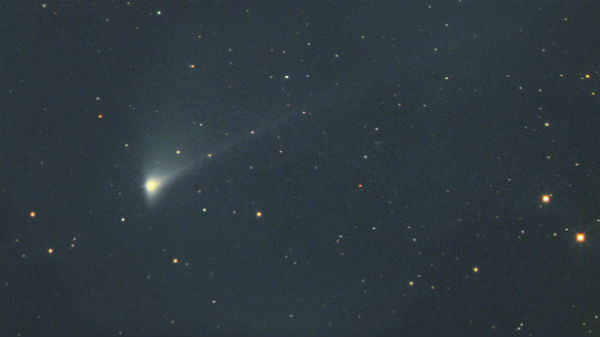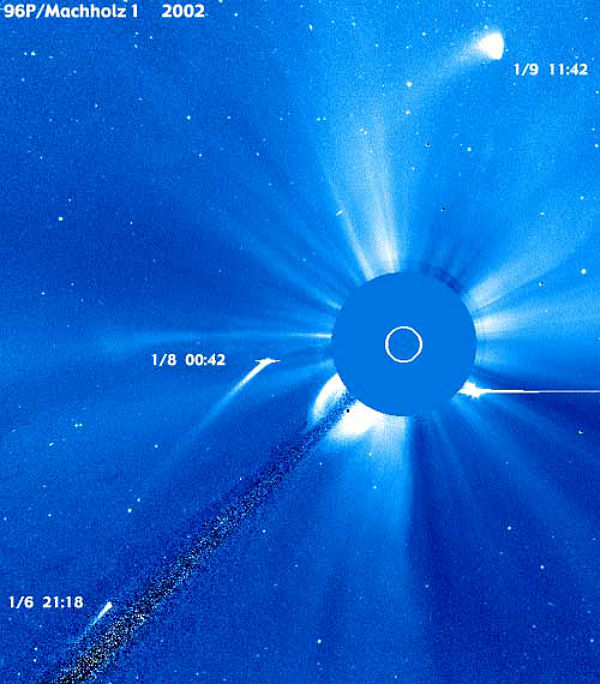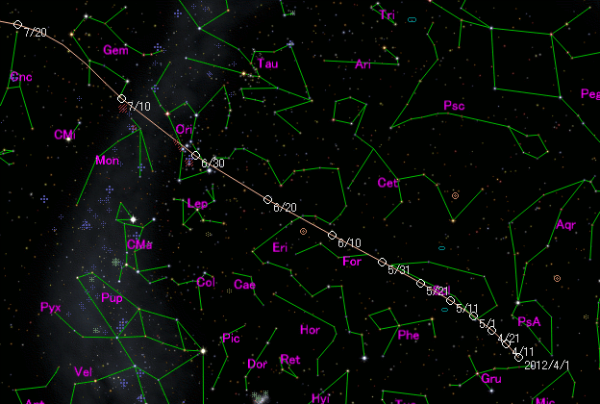Comet 96P/Machholz visible on SOHO’s LASCO C3 between July 12 – 17

Comet 96P/Machholz will next come to perihelion on July 14, 2012. Between July 12-17, 2012, comet Machholz will be visible in the SOHO LASCO/C3 field of view and will brighten to about magnitude +2. It should be visible from both STEREO A and B between July 13-15. Comet 96P/Machholz has an estimated radius of around 3.2km.
96P/Machholz or 96P/Machholz 1 is a short-period comet discovered on May 12, 1986 by amateur astronomer Donald Machholz on Loma Pieta peak, in central California using 130 millimetres (5.1 in) binoculars. On June 6, 1986, comet 96P/Machholz passed 0.40373 AU (60,397,000 km; 37,529,000 miles) from the Earth.

Machholz 1 entered the field of view of the orbiting Solar and Heliospheric Observatory (SOHO) in 1996, 2002, and 2007, where it was seen by the corona-observing LASCO instrument in its C2 and C3 coronagraphs. During the 2002 passage the comet brightened to magnitude -2,and was very impressive as seen by SOHO. During the comet’s last perihelion passage in 2007, it appeared in SOHO’s LASCO C3’s field of view from April 2 to April 6, peaking in brightness on April 4, 2007, around magnitude +2. In these observations, its coma was substantially smaller than the Sun in volume, but the forward scattering of light made the comet appear significantly brighter.

Machholz 1 is unusual among comets in several respects. It’s highly eccentric 5.2 year orbit has the smallest perihelion distance known among numbered/regular short-period comets, bringing it considerably closer to the Sun than the orbit of Mercury. It is also the only known short-period comet with both high orbital inclination and high eccentricity. In 2007, Machholz 1 was found to be both carbon-depleted and cyanogen-depleted, a chemical composition nearly unique among comets with known compositions. The chemical composition implies a different and possible extrasolar origin.
There are currently three hypotheses to explain the chemical composition of Machholz 1. One hypothesis for the difference is that Machholz 1 was an interstellar comet from outside the Solar System and was captured by the Sun. Other possibilities are that it formed in an extremely cold region of the solar system (such that most carbon gets trapped in other molecules) – Oort cloud. The high inclination of Machholz 1’s orbit, 59°, suggests that it could came from the Oort Cloud rather than the Kuiper Belt, which is the source of most short-period comets. Given how close it approaches the Sun at perihelion, repeated baking by the Sun has stripped most of its cyanogen.

96P will not make another close approach to the Earth until 2028, when it will pass at a distance of 0.319 AU (47,700,000km; 29,700,000 miles).
Transits of Objects through the LASCO/C3 field of view (FOV) in 2012
The Unusual Spectrum of Comet 96P/Machholz
Sources: JPL Small-Body Data Browser, Aerith.net, SOHO, Sky&Telescope
Featured image: Apr. 16, 2007 Michael Jager & Gerald Rhemann

Commenting rules and guidelines
We value the thoughts and opinions of our readers and welcome healthy discussions on our website. In order to maintain a respectful and positive community, we ask that all commenters follow these rules.